LCAs, EPDs, GWP … many engineers attempt to dive into the world of sustainability and find themselves swimming in a sea of acronyms. While a designer might wish—or need—to incorporate sustainability into projects, the lack of concise background information can leave someone new to sustainability feeling quite intimidated. Rest assured that integrating carbon reduction into designs can be as simple as adding a couple of columns to an existing design spreadsheet.
Carbon emissions, such as CO2 and other greenhouse gases, directly associated with the building and construction sectors are responsible for about 40% of the annual emissions generated globally [1]. Digging deeper, the iron and steelmaking industry is responsible for 7-8% of annual carbon emissions produced globally [2]. Roughly 50% of all steel produced serves the construction (building and infrastructure) sector [3], so structural engineers have a direct influence on about 4% of global carbon emissions when using steel.
KEEP IN MIND The design with the lowest material quantity or the product with the lowest GWP may not always be the most sustainable option. Always consider embodied carbon when designing for sustainability, not just material quantity or GWP.
Several state and local governments are exploring such laws as Buy Clean legislation to impose carbon limits on building products during procurement. Carbon criteria have also begun to be included in private development projects. Therefore, it is imperative for structural engineers to become familiar with sustainable design procedures and strive to reduce embodied carbon on their projects.
What Is Embodied Carbon?
For structural engineers, the primary focus in the realm of sustainability is on embodied carbon. Embodied carbon is the measure of CO2 and other greenhouse gases emitted into the atmosphere that can be attributed to a building’s materials and its construction. Activities in this category include the extraction of raw materials, refinement and manufacturing of materials into products, transportation of those refined products, construction of the structure, and the deconstruction and disposal of materials at the end of a structure’s life cycle (Figure 1).
Measuring Embodied Carbon
The world of sustainability has many complexities; thankfully, the measurement of embodied carbon is not one of them:
Embodied Carbon = Material Quantity x Carbon Factor
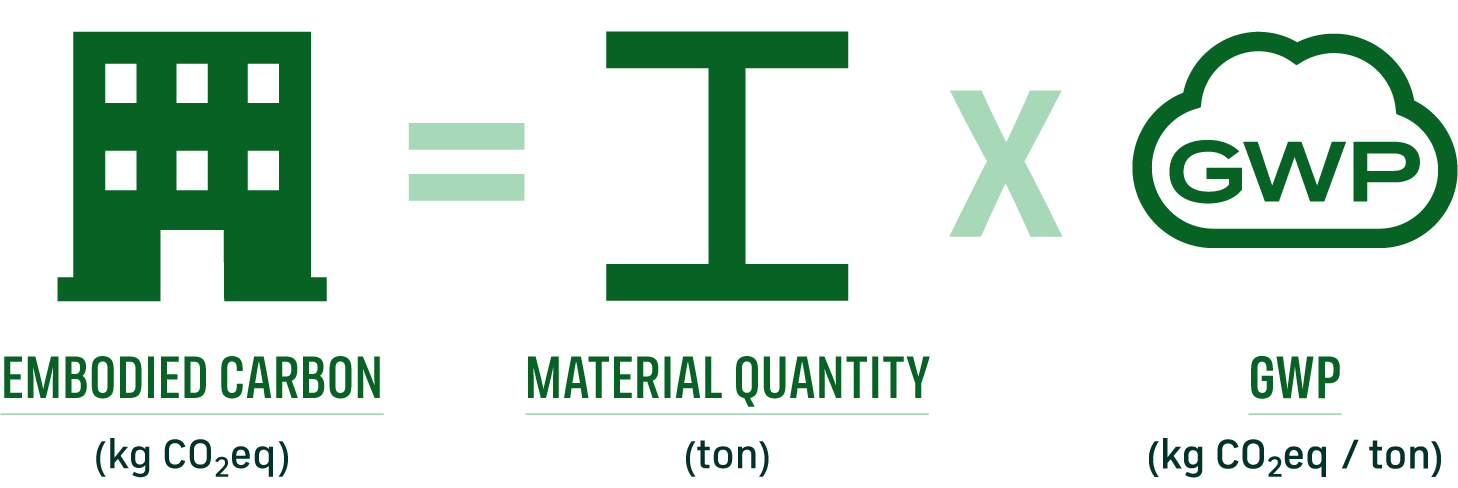
This calculation is performed for each building material to be used (wide flange steel, metal decking, concrete, rebar, etc.) and then summed to attain a total embodied carbon value for the design.
Engineers determine material quantities for their structures (i.e., cubic yards of concrete or tons of steel) through typical design procedures. The carbon factor, often referred to as carbon intensity or emission intensity, is a multiplier providing the carbon emissions produced per unit of material quantity to measure the potential impact on the environment. Global Warming Potential (GWP) is the metric typically used to measure a product’s carbon footprint. GWP includes CO2 as well as any other gas emitted that has the potential to increase the earth’s mean temperature. The quantity and impact of gases are scaled relative to CO2, combined, and quantified in units of kilograms of CO2 equivalent (kg CO2e).
Environmental Product Declarations
GWP values are found in Environmental Product Declarations (EPDs). EPDs are third-party verified reports that transparently document the environmental impact of a building product over its life cycle. The EPDs must conform to a set of accounting rules known as Product Category Rules (PCR) and ISO standards. Care should be taken to ensure proper ISO standards are met, and PCRs are matching when comparing materials or steel from other countries outside of the United States to have an equal EPD comparison. EPDs typically cover impacts from the product stage (A1-A3 per Figure 1), which are referred to as “cradle-to-gate.” It is important to understand the boundaries or stages covered by each EPD as it can vary, such as the difference between EPDs for “fabricated” versus “unfabricated” steel products. An EPD also documents various environmental impact categories, such as Ozone Depletion Potential (ODP) or Acidification Potential (AP), as well as energy consumption and waste.

In simpler terms, the EPD is analogous to a nutrition label and documents the product’s impact on the environment instead of food to one’s body. The material quantity parallels the serving size, and the GWP corresponds to calories per serving. The additional impact categories can be thought of as the various macronutrients.
The two primary types of EPDs are industry-wide EPDs (IW-EPDs) and manufacturer EPDs. Manufacturer EPDs are also sometimes referred to as product EPDs. Industry-wide EPDs are produced by industry organizations such as AISC or SDI that provide GWP values representing a weighted average over a representative sample of suppliers for a given type of product. Manufacturer EPDs are produced by an individual supplier for a specific product. If a supplier produces the same product type at multiple facilities, the supplier may elect to establish separate site-specific EPDs or list the GWP for each facility under one EPD.
Sustainable Structural Design Considerations
Initial Design and Material Selection
The first step of integrating carbon reduction into structural design is to choose the most appropriate material or product (ex., wide flange v. HSS) for the given project or application. There is no single material or product considered to be the most sustainable. Thus, multiple options and hybrid solutions should be considered. Engineers should calculate embodied carbon using each respective material quantity and associated GWP for the designs being considered. It is recommended that engineers use industry-wide GWP values in the early phases of design since product sources will not be known until a project’s procurement team purchases the material.
Keep in mind that the design with the lowest material quantity or the product with the lowest GWP may not always be the most sustainable option. Always consider embodied carbon when designing for sustainability, not just material quantity or GWP!
Steel Sourcing Considerations
Steel manufacturing can be subdivided into two principal processes: “extractive” blast furnace-basic oxygen furnace (BF-BOF) production and “circular” electric arc furnace (EAF) production. Powered by coal and fossil fuels, BOF mills extract and use raw materials (primarily iron ore, coal, and limestone) and up to 30% recycled scrap metal to produce steel. By contrast, EAF mills use electricity to melt down and recycle scrap metal (up to 99%+ recycled content) and direct-reduced iron (DRI) to repurpose old metals and make new steel.
EAF steel is a much more efficient and sustainable means of producing steel. Per the World Steel Association, every ton of steel produced in a BOF facility emits an average of 3.5 times more carbon into the atmosphere compared to an EAF facility (Figure 2). Therefore, any project striving to be more sustainable must prioritize the use of EAF-produced steel.
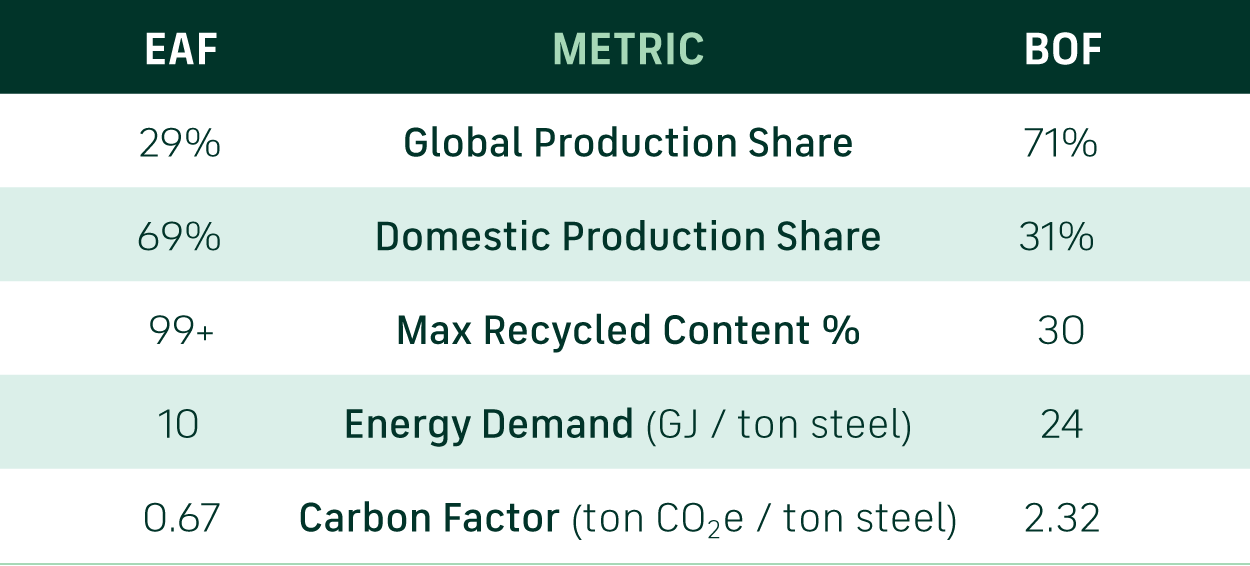
It is important to note that different steel products have different ranges of GWP values (Figure 3). This is closely related to the percentage of recycled content of which the product is composed. Thinner steels, such as sheet mill products, including hollow structural sections and metal decking, require more virgin iron and alloys relative to scrap metal in order to maintain surface quality during the roll-forming process. Products with reduced surface quality concerns, such as rebar, can have nearly 100% recycled content.
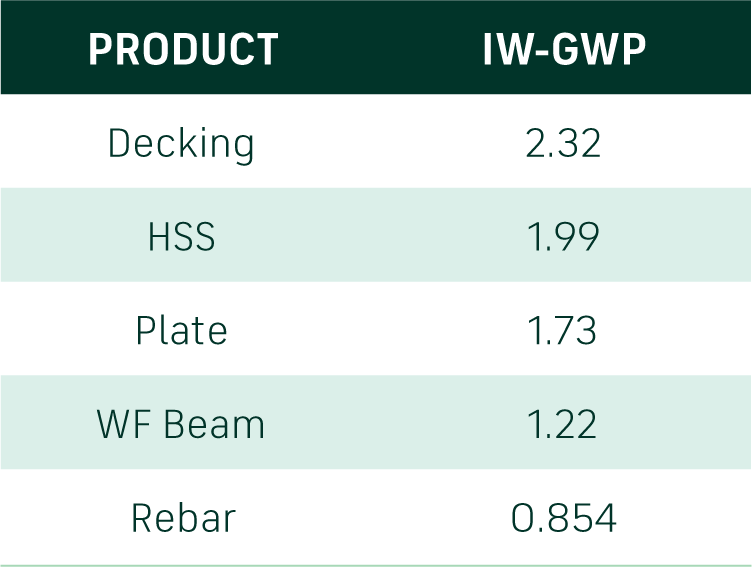
Design Optimization
Carbon reductions can be further achieved through conventional design refinement, the exploration of new technologies, and the use of high-strength materials. There are established and emerging structural technologies in the marketplace that can facilitate a sustainable project. Reach out to suppliers directly to inquire about availability and applicability to your project.
Here are a few easy-to-implement solutions:
- Grade 65 Wide Flange Sections (ASTM A913): Grade 65 structural steel should be the new normal for strength-controlled elements such as columns and truss elements. A 10-25% tonnage reduction can be expected for only a slight cost premium from the mill and no difference in lead time compared to traditional A992. In addition, there are enhanced weldability characteristics inherent to ASTM A913 Grade 65 steel. Also, inquire about the availability of Grades 70 and 80, as they are emerging in the market.
- Grade 80 Rebar (ASTM A615 or A706): Explore replacing typical Grade 60 rebar in vertical or direct tension elements (columns, shear walls, etc.) for larger diameter bars (typically #10-#11). In addition to tonnage reductions of over 5-15%, horizontal tie requirements and congestion can be reduced from those of Grade 60.
- Design with a yield strength of 50 ksi and specify ASTM A500 Grade C for all HSS sections (rectangular/square and round). Do not specify pipe (ASTM A53, Fy = 35 ksi) sections unless required.
- Design with a yield strength of 50 ksi for all angles and channels.
DID YOU KNOW? All wide flange sections produced in the United States are made in EAF mills, and only five W sections in the AISC steel manual are not currently domestically produced? Contact your steel suppliers to understand section availability.
Specification Updates and Selective Procurement
Selectively procuring more sustainable materials is another layer of embodied carbon refinement. Designers can implement the use of sustainable materials on a project by updating and expanding project specifications. Below are recommended changes to project specifications that can increase the sustainable qualities of a project:
Step 1: Require the submission of manufacturer EPDs for each product (wide flange, HSS, plate, decking, rebar, etc.) as formal submittals to be reviewed by the design team. This will allow designers to refine their embodied carbon calculations beyond industry-wide GWP assumptions and allow the procurement teams to review GWP information if required per Step 2. The EPDs submitted should provide the specific facility GWP values from which the product is to be procured.
Step 2: Establish maximum GWP limits as material procurement criteria for each product. Products exceeding GWP thresholds may not be procured.
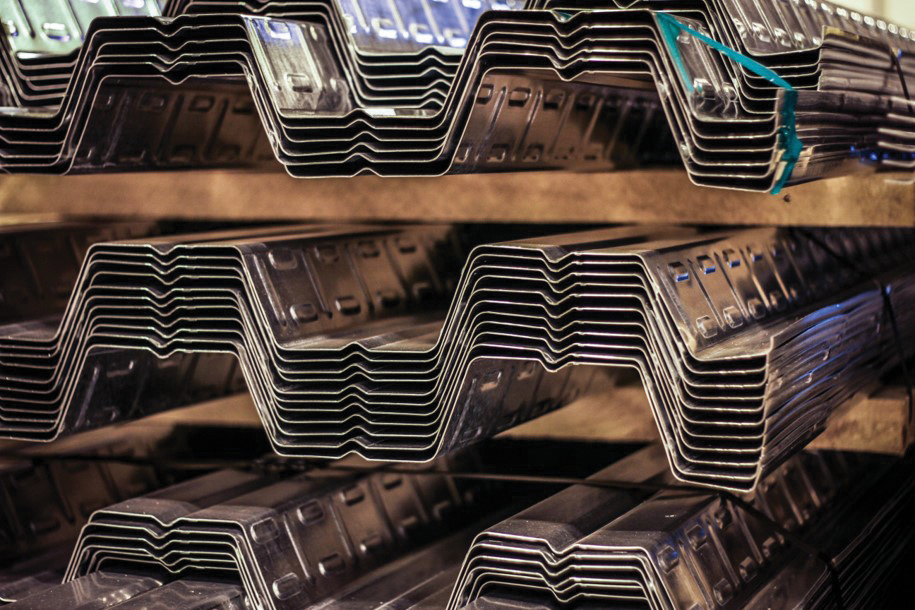
It is recommended to allow for some percentage (5-15%) of nonconforming material to provide purchasing flexibility in these early stages of sustainability documentation.
Many specifications currently indicate minimum recycled content percentages. These requirements are generally quite conservative and not overly impactful. Specification writers may require the submission of recycled content letters but should ultimately allow the GWP requirements to govern procurement decisions.
If any new materials or proprietary technologies are used in the design, they must be added to the specifications, and General Notes drawings as allowable or required materials.
Sustainable Design Example
The graphic below shows a short design case study that illustrates how easily embodied carbon reductions can be achieved.
Life Cycle Assessments
Life cycle assessments (LCAs) take simple embodied carbon calculations to the next level. Embodied carbon calculations consider the GWP for products used in the construction of a structure. LCAs, on the other hand, consider the GWP for the manufacturing of the products, construction methods, maintenance and service life factors, and end-of-life scenarios. Thankfully, there are many tools at an engineer’s disposal to measure the impacts of building materials on the environment. Many of these tools are free, plug into software that engineers use daily, and provide detailed impact breakdowns of buildings—all at the click of a button. Whole Building LCAs are the 201 level to the 101 embodied carbon calculations. By assessing a building over its entire life cycle, more design considerations and time-dependent scheme comparisons can be unlocked.
Conclusion
Structural engineers have the opportunity to make a positive, dramatic impact on the greenhouse gases emitted across the globe. In the not-so-distant future, embodied carbon will be considered equally important to cost and constructability to align with new legislation and project requirements. Armed with baseline sustainability knowledge and the aforementioned recommendations, structural engineers can effectively reduce the carbon footprint of their structures. ■
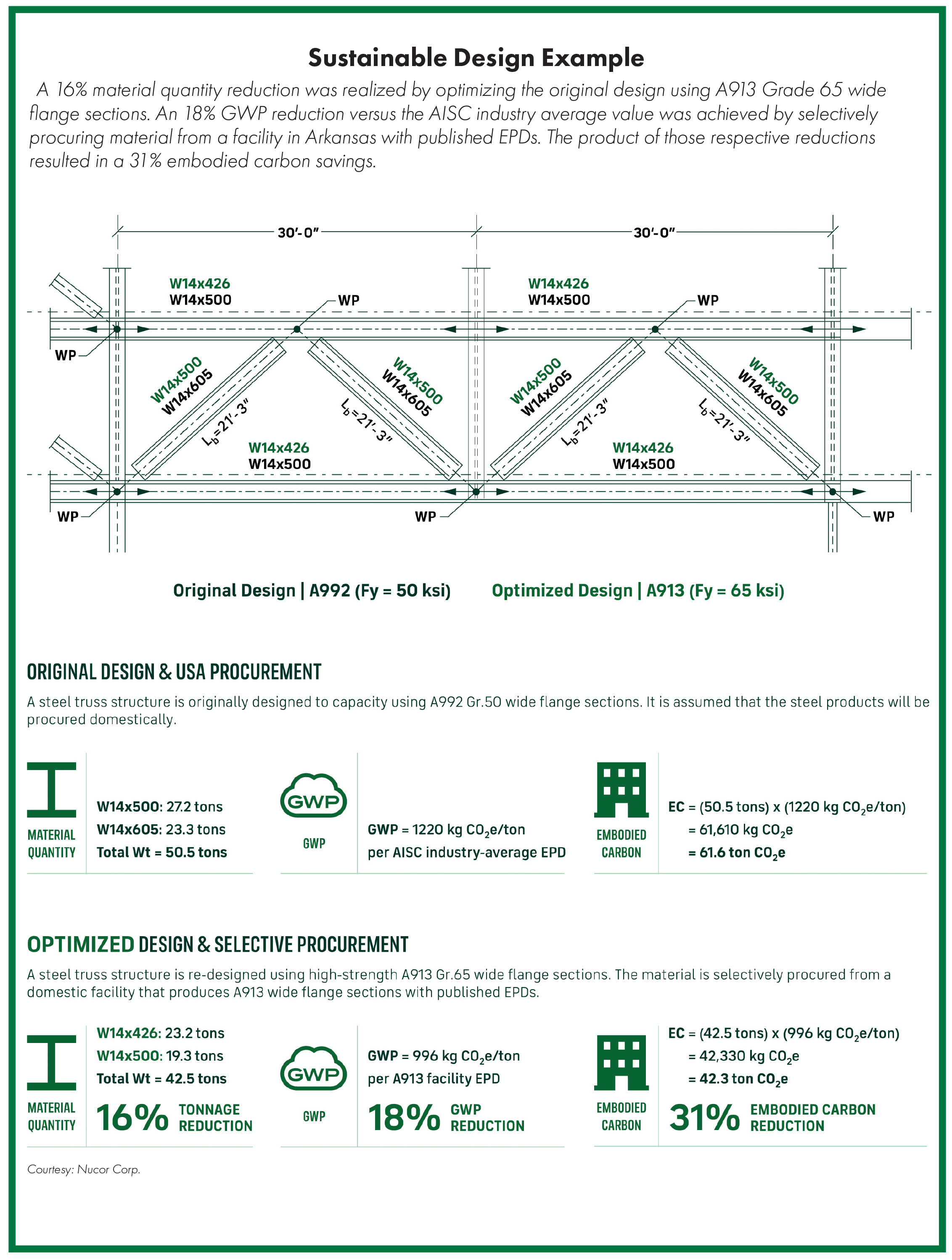
REFERENCES
[1] World Green Building Council. https://worldgbc.org/article/2019-global-status-report-for-buildings-and-construction/
[2] International Energy Agency. https://www.iea.org/reports/iron-and-steel-technology-roadmap
[3] The World Steel Association. https://worldsteel.org/wp-content/uploads/Sustainable-steel.pdf
[4] The World Steel Association. https://worldsteel.org/steel-topics/sustainability/sustainability-indicators/
